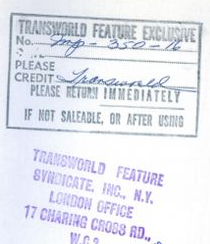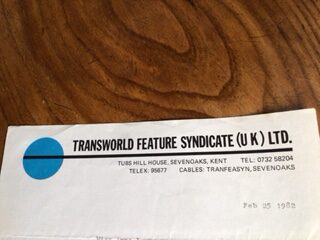

This in from PPHP reader Robin Kirby who has contacted us a few times looking for information on Transworld for a book he is writing which includes the history of the agency. If you have information for Robin please contact the PPHP first and we will put you in touch [email protected]
Hi Will,
I’ve been working on the book From Cents to Pence! which, for the first time, details the history of Marvel Comics in the UK. While I hope to finally complete this soon, as a result of many years of research I’m in the very fortunate position of now being able to shed at least some new light on the origins of the previously mysterious company known as Transworld Feature Syndicate Inc. and also some more information about their UK office: Transworld (UK) Ltd.
By necessity, what follows is only a brief overview, as the fuller story needs far more space than can sit neatly within a blog post… and I do have a book to sell (eventually) :)
The New York-based Transworld Feature Syndicate Inc. was formed in 1950 by Ida Landau, before later being run by her son Albert after ill health forced Ida to take a back seat. The core of the business was selling feature material and photos to publishers around the world, and as the name suggests they soon had offices located right around the globe from Paris to Oslo, and Stockholm to Buenos Aires, as well as many other major cities. During the latter years of that decade, Albert gained a new client in Martin Goodman, and began managing the distribution rights to reprints of material from both the Marvel Comics and Magazine Management parts of his business, before going onto to also do the same for other New York-based comic book companies of the era.
In 1968, the well-regarded former sports reporter Ray Wergan (not Wergen, as posted above), then working in NY, came into contact with Al Landau on his return visits when not running Transworld’s London office. A close friendship developed, which eventually provided Landau with a means to permanently return home to New York, when Wergan came to him “with an offer he couldn’t refuse”. Life magazine was seeking an independent agent in London who came with the backing of an established agency not already in the news field, and they wanted Ray Wergan to help develop their business in Britain. Landau could immediately see the potential, and so a plan was agreed that Ray would come home to London and run the Transworld business for him there, adding the Life contract to their present workload.
Ray was hugely impressed by the scale of Landau’s operation. In the book he records that, by then, Albert had turned Transworld in London into “the major supplier of material to the woman’s magazine market through publishers such as Odhams, Newnes and Fleetway”. They had also started to supply large scale illustrations, renting an out-of-London premises that top US illustrators could work out of, so as to make their contacts with the magazine’s editors easier to magazine in that era prior to instantaneous transfer of visuals via e-mail or electronic storage sites.
Landau returned to New York in 1968, as the pair had originally planned, leaving Ray to manage London. By 1971, things were going so well that, in line with company policy of ‘letting managers manage’, the London business was sold to him, whilst remaining a key part of the international group. Now known as Transworld (UK) Ltd., it was at this time that Marvel Comics came knocking. They were fed up with licensing material to publishers over here, only for it to be refashioned in ways not to their liking, and having had a joint publishing venture crash with another company at the last minute, they were keen to get a weekly comic back on to British newsstands as soon as possible.
At a meeting in London in the spring of 1972, it was decided to create a new British comics division – a unique proposition which no US publisher had attempted before. The comics would be compiled by Marvel mainly in New York, with London adding editorial material and advertising, as well as arranging the printing, and the business would be run out of Wergan’s offices at High Holborn (before a later move to Sevenoaks in Kent). Talk of employing a full-time manager never came to pass, and in the end he would continue to oversee the London side of their British comics division for the first six or so years of it’s decades long existence, making full use of his Fleet Street contacts to promote their growing range of titles in the press and on TV and radio.
Coinciding with former IPC and Williams editor Dez Skinn taking over running their British comics completely – with their entire output now produced entirely in London with minimal US input for the first time – Ray Wergan had just won world syndication rights to material from TV Times magazine, granting him access to a superb picture library that had yet to be exploited internationally. Thereafter, Transworld (UK) Ltd. would continue to flourish, supplying materials for publication right across the print industry, until Wergan’s retirement in 1988 when their picture library was sold to Scope (which I can see from the PAN site has recently gone out of business).
As to the final demise of Transworld Feature Syndicate Inc. in New York, however, this remains a mystery to me. Did they sell-up, get bought out, or even go under? If anyone reading this who worked for the US division during the 1980s could enlighten me, I’d be hugely grateful.
In the meantime, all the best with the Press Photo History project. This is an invaluable endeavour and I hope your researches continues to go from strength to strength. As you’ll gather, I’m a great believer in the need to preserve modern history for the continued use of future generations, as it’s all too easy to see such history left unrecorded and its artefacts skipped and destroyed (or, indeed, buried under a building somewhere).
••ENDS••
Good work Robin! If you have information for Robin please contact the PPHP first and we will put you in touch [email protected]